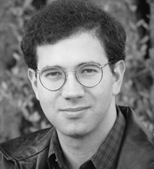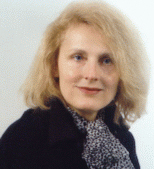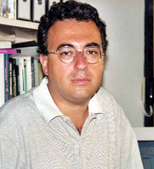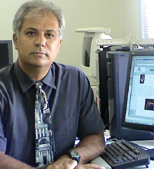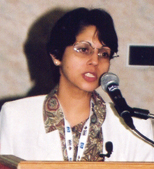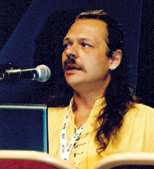
|
{
C O N T E N T S } 2003 ISCB Membership Registration Now Open Application Deadline to Host ISMB 2004 or 2005 SGI Awards Best Paper and Best Poster Awards at ISMB 2002 CAPRI and ECCB Travel Fellowship Recipients Bourne Receives Sun Convergence Lifetime Achievement Award Download Newsletter pdf |
|
ISCB Welcomes Six New Board Members The ISCB welcomes six new members to its board of directors. Steven Brenner, Rita Casadio, Roderic Guigo, Goran Neshich, Shoba Ranganathan, and Burkhard Rost were voted in during an annual Board meeting, held August 5, 2002, in conjunction with ISMB 2002. The new Board members were elected based on nominations gathered from the membership. The new members were elected to three-year terms as four other members completed their service to the Society.
“I am pleased to welcome the new Board members. They demonstrate the depth, scientifically and geographically, of the Society as a whole, and will particularly enhance the voice of the Society in their regions while providing an international representation on the Board of Directors,” said ISCB President Phil Bourne. Steven E. Brenner, Ph.D., is assistant professor and leader of a computational genomics research group at the University of California, Berkeley. His research interests include computational approaches for structural genomics and sequence analysis, and the use of both of these to infer-molecular function. Brenner was educated and trained at Harvard University, the MRC Laboratory of Molecular Biology and Cambridge University, and Stanford University. More about his research group may be found at compbio.berkeley.edu.
Rita Casadio, Ph.D., is a professor of biophysics and group leader of the biocomputing unit at the Inter-departmental Centre for Biotechnological Researches at the University of Bologna, Italy. Casadio has worked on biophysics in laboratories both in the US and Germany. Her current research focuses on theoretical and experimental membrane and protein biophysics. Presently she is interested in computer modeling of relevant biological processes, such as protein folding. This she applies to her research on the application of neural networks to the prediction of secondary structure of proteins from their residue sequences. More about her research may be found at www.biocomp.unibo.it.
Roderic Guigo, Ph.D., is a researcher at the Institut Municipal d’Investigació Mèdica, an Associate Professor at the Universitat Pompeu Fabra, and coordinator of the Bioinformatics Program at the newly created Center for Genomic Regultaion in Barcelona. Guigo obtained his Ph.D. in 1988 from the Universitat de Barcelona where he worked at the Department of Statistics with advisor, Jordi Ocaña. Guigo conducted postdoctoral research as a fellow with Temple F. Smith at Harvard’s Molecular Biology Computer Research Resource. Ongoing work with Smith includes several sequence analysis projects. Guigo continued his postdoctoral research with Los Alamos National Laboratory’s Theoretical Biology and Biophysics Group where he worked on genome analysis with James W. Fickett. Following this, Guigo returned to the Universitat de Barcelona where he worked in the Department of Statistics. More about his research may be found at www1.imim.es/main/research.html.
Goran Neshich, Ph.D., is a structural bioinformatics group leader at the Brazilian Enterprise for Research in Agriculture (EMBRAPA), Informatica Agropeciam, Compines, Brazil. Neshich started his work in structural bioinformatics while studying structure and function relationship of the photosynthetic reaction center during his graduate work done with Don DeVault at the University of Illinois at Urbana-Champaign. He conducted his postdoctoral research with Barry Honig at Columbia University. Neshich is the principal author of STING and the STING Millennium Suite, a popular software application for presentation of macromolecular interactions, structure analysis, and visualization. STING is accessible from the Protien Data Bank (PDB), www.pdb.org. He is continuing to develop tools for comprehensive presentation of physical-chemical properties of proteins (Protein Dossier) and applying those to generate structure/function descriptors. His latest initiative is developing the Protein Dossier to be suitable for presentation of results obtained and used in drug and drug target identification and chemogenomics. More about his research may be found at www.cbi.cnptia.embrapa.br.
Shoba Ranganathan, Ph.D., is an associate professor of biochemistry and biological sciences at the National University of Singapore. Ranganathan’s research focuses on: protein structure comparison, prediction and modeling and function prediction; creation and mining of boutique databases for computational biology and immunology; alternate splice variants and intron-exon evolution; comparative genomics and organism-based transcription regulation; and developing Grid computing applications in bioinformatics. Ranganathan has served as the Vice President of the Asia Pacific Bioinformatics Network (APBioNet) since January 2000; and as the Secretary of S* Life Science Informatics Alliance since July 2000. More about her research may be found at surya.bic.nus.edu.sg/shoba.
Burkhard Rost, Ph.D., is an associate professor of biochemistry and molecular biophysics, Columbia University, New York, USA. Rost’s research focuses on the prediction of protein structure and function by combining means from simple statistics to artificial intelligence and evolutionary information. His group is currently also working on the following projects: to improve and extend the EValuation of Automatic protein structure prediction (EVA) server to continuously evaluate structure prediction; to improve methods to predict secondary structure and solvent accessibility; to build a database of predictions for entire genomes; and to predict structural domains from sequence. More generally, his group attempts to shift focus from predicting structure to predicting function. More about his research may be found at cubic.bioc.columbia.edu. The ISCB Board of Directors consists of 30 members who lead committees on awards, conferences, education, finance, nominations, and publications. |

